Christine Valters Paintner's Blog, page 83
February 16, 2019
7 pilgrimages you can go on right now (Part 1) ~ A Love Note from Your Online Abbess
 Dearest monks, artists, and pilgrims,
Dearest monks, artists, and pilgrims,
There are many ways to practice pilgrimage. You can journey far away to a sacred site, but there are also options within reach of a walk or drive from home, or even within your own imagination. Keep in mind these three essential aspects to create your own pilgrimage experience:
Begin with an intention and prayer or blessing for this time.
Stay open to the ways God might break in through the unexpected.
When you return, spend time in reflection on how this experience has touched you. What new discoveries or invitations did you hear?
Walking is a wonderful way to get out of our heads and into our bodies. If mobility issues prevent this, know that imagining yourself walking to each suggested site can have the same impact. God is present to us in whatever ways we are able to receive the sacred.
Make a local pilgrimage
Chances are you live near a church or perhaps even several churches. You could choose to make a pilgrimage to your local cathedral. Using the three essential aspects, make it a sacred experience by blessing the journey there, paying attention for divine whispers along the way, and then reflecting when you return home. You might look up the church calendar to see if there is an upcoming feast day that feels especially appropriate for your journey and let that shape your prayer.
In a more urban area, plan a walking pilgrimage from one church to another. Research the churches and map out a route. Look up the various saints they are dedicated to and write a note for each of them. Offer a prayer to each saint as you make each stop. Spend 15 minutes in silence at each of the churches. Listen for what is offered to you. Remember that what can feel like interruptions or disruptions to your plans may contain the sparks of an encounter with the divine.
If you live in a rural area, still try this suggestion out, but you may need to drive between sites. Try keeping the car radio off to maintain an atmosphere of quiet reflection.
Begin your pilgrimage by reading the Road to Emmaus (Luke 24:13–35) as a blessing for this time. Listen along the way for how the holy is being revealed to you.
Make an ancestral pilgrimage
One of my favorite forms of pilgrimage is to journey to ancestral places and experience the landscape of those from my bloodline who traveled the earth before I did. However, sometimes these places are far away and require a lot of time and expense to reach.
If you live near a family cemetery, visit graves of loved ones who have passed away with the intention of making it a pilgrimage. Hold the image of the communion of saints and the Scripture image of being “surrounded by so great a cloud of witnesses” (Hebrews 12:1) as you make this journey. Feel yourself surrounded by the love of thousands who have come before you. Offer gratitude for all the ways they endured so that you might live. You could choose to make this pilgrimage during November, which is the month of remembrance of the dead, or on the anniversary of an ancestor’s birth or death.
If you have no ancestral connections close by, visit the local cemetery anyway. Pray for the people there and their families. Feel their connection to this place where you live and all the ways they may have contributed to making it the community that it is.
Make a nature pilgrimage
You might choose to make a pilgrimage to a nearby place in nature. This could be a local park that you love or even your backyard. Locate the closest forest, river, seashore, or mountain, remembering all of the holy landscapes in Scripture such as the Jordan River, the Sea of Galilee, Mount Horeb, or Mount Sinai.
Begin your pilgrimage by reading Psalm 104 and asking for the clarity to hear all of creation joining in an ongoing hymn of praise. As you walk let this be a time of contemplative listening for the more-than-human voices that surround you. Spend time with things that call to you along the way, whether a pinecone in your path, a smooth stone, moss on the trees, or a flower growing. Pay attention to the birds and animals that make this place their home, and call to mind the desert and Celtic saints who saw intimacy with animals as a special sign of holiness. Find a quiet place on your journey to sit for a time in silence and simply receive the gifts being offered to you.
This article also appears in the July 2018 issue of U.S. Catholic (Vol. 83, No. 7, pages 12–17) and on their website.
Please join us for our Lenten online retreat as we journey through my book The Soul of a Pilgrim together in community. Our early registration price ends tomorrow (February 18th!)
With great and growing love,
Christine
Christine Valters Paintner, PhD, REACE
Photo © Christine Valters Paintner
February 12, 2019
Monk in the World Guest Post: Elaine Breckenridge
I am delighted to share another beautiful submission the Monk in the World guest post series from the community. Read on for Elaine Breckenridge's reflection on letting go of climbing and searching.
"In 2007, I climbed a mountain on Inis Mor, one of the Aran Islands off the coast of Ireland.Well, it was really a hill but it might as well have been a mountain. The goal of the climb was to visit a tiny little hermitage perched on top. Called the Teampall Bheanain, it is reputedly the smallest church in Ireland. It dates from about the 7th century.
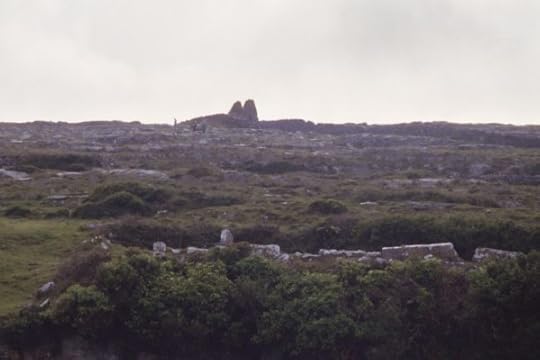
From the bottom of the holy hill, it looked like a reasonable climb, and so I happily set off. But the going got both rough and tough. It wasn’t about the incline. It was about the rocky soil. There were boulders to dodge or climb over. There were moss covered rocks that were deceptively slippery. There were loose stones making it all too easy to roll an ankle. It was a feat to make it to the top. But when I arrived, the view was worth the trek. There was a lovely view of the countryside below on one side and on the other, a magnificent view of the sea. Sacred cows enjoyed their leisure. It was breathtaking. After I took the picture below, the sun began to set. Streams of light kissed the sea and land. I could understand why monks had a cell there. I could imagine long comfortable hours of solitude not loneliness.
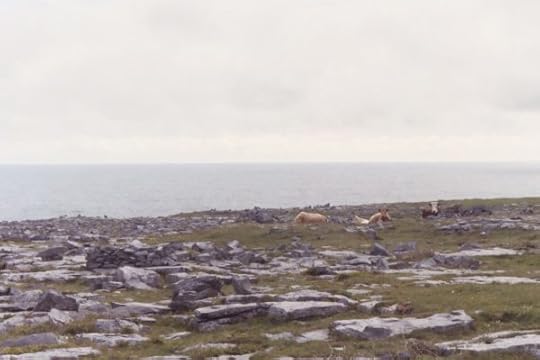
You can’t stay at the summit forever and so I began the descent down. What a disaster that was! Scrambling down the hill was treacherous. Gravity pulled me over those same difficult stones and rocks in even more dangerous ways. It took every bit of mental concentration to control the proper placement of footing in order to remain safe. I understood why a monk would stay up there days at a time. It was in fact difficult to come down from that mountain top!
In the pre-Christian Celtic religion, hills were holy places, thin places that were climbed so that one could be near the sky gods. Climbing then was already an important feature of their spirituality. When Christianity came to Ireland, the earliest missionaries found a people receptive to the notion of God coming from heaven in the birth of a person named Jesus. Christian Celtic preachers and teachers, using their gifts of imagination put flesh and bones on the Christian doctrine of the Incarnation. In his book, A Holy Island Prayer Book, Anglican priest, Ray Simpson describes God bounding down a rocky mountain with a hand reaching out in love to the people waiting below.

Having gone up and down that rocky Irish hill, I can see how that metaphor perfectly illustrates the grace of God. The spiritual life is about receiving God, who with a sense of urgency and joy leaps over boulders and runs down a rocky hill, just in order to be with us. It is not about making an arduous trip up and down a difficult hill. Instead it is waiting with expectant hearts for God to come to us.
Faith often calls us to let go of our climbing and searching so that we can experience God coming into our presence without our effort. Yet, that can be a challenge for a person like me who wants to be active, involved and yes, even in charge of my spiritual journey.
In 2016, I returned to that same holy hill and looked forward to making the ascent again. But nine years later with an arthritic hip, I couldn’t do it. It was disappointing. Then, I remembered Ray Simpson’s lovely metaphor. I sat down, rested and sure enough God’s peace and joy filled my heart. Receptivity brought boundless grace.
Pilgrimages and hikes are certainly thin places. But so too is carving out time for stillness. We don’t always have to climb a hill, or take an exotic journey. It’s comforting to experience this fact, especially when dealing with aging and health issues. Finding a quiet and comfortable space and inviting God to do the rest really does work. If you have not taken that path recently, try it. It will be well worth the journey."
 Elaine Breckenridge is a dancing monk and an Episcopal priest currently serving St. John the Baptist Church in Lodi, California. Her passions include incorporating Celtic and Creation Spirituality into traditional liturgical forms, the music of Kristopher E. Lindquist (Kelmusic.com), yoga and living the Abbey of the Arts Monk Manifesto.
Elaine Breckenridge is a dancing monk and an Episcopal priest currently serving St. John the Baptist Church in Lodi, California. Her passions include incorporating Celtic and Creation Spirituality into traditional liturgical forms, the music of Kristopher E. Lindquist (Kelmusic.com), yoga and living the Abbey of the Arts Monk Manifesto.
February 9, 2019
Poetry and the Sacred (new videos and featured poet series) ~ A Love Note from Your Online Abbess
Dearest monks, artists, and pilgrims,
In celebration of publishing my new collection of poems, Dreaming of Stones, we are delighted to be working with local video production company Morgan Creative to launch a series of poetry videos.
I have two to share with you today:
First, enjoy this one-minute book trailer they created with gorgeous images from Ireland.
Wings
I wake from a dream,
reach towards day as it hatches,
its tiny beak presses against
the delicate shell of sky.
Today I might learn to fly.
—Christine Valters Paintner, poem appears in Dreaming of Stones: Poems
Dreaming of Stones book trailer from Christine Valters Paintner on Vimeo.
We will be sharing this series of poetry videos every other week through the spring. I love how images have amplified and deepened the meaning of the poems for me. I hope they offer you a holy pause amidst the rush of life.
This first poem video accompanies the title poem of the collection:
Dreaming of Stones – Poem Video from Christine Valters Paintner on Vimeo.
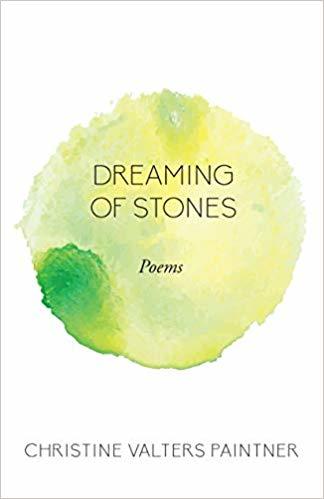 Dreaming of Stones
Dreaming of Stones
In the world before waking
I meet a winged one,
feathered, untethered,
who presses in my palm
three precious stones,
like St. Ita in her dream,
but similarities end there,
her with saintliness and certainty,
me asking questions in the dark.
All I know is
I am not crafted from
patience of rock or gravity of earth,
nor flow of river,
I am not otter with
her hours devoted to play.
I am none of these.
At least not yet.
The stones will still be singing
centuries from now,
made smooth by
all kinds of weather.
If I strike them together,
they spark and kindle.
Do I store them as treasures
to secretly admire
on storm-soaked days?
Or wear them as an amulet
around my neck?
When the angel returns to me
in the harsh truth of last morning,
will she ask
what have I endured,
treasured, and sparked?
Will she ask what have I hidden away
and what made visible?
(title poem from Dreaming of Stones, first appeared in Spiritus Journal)
With great and growing love,
Christine
Christine Valters Paintner, PhD, REACE
February 5, 2019
Abbey of the Arts Featured Poet: Kenneth Steven
We are launching a new series this spring with poets whose work we love and want to feature!
Our first poet is Kenneth Steven whose work is deeply inspired by the island of Iona. You can hear Kenneth reading his poem "Iona" below and read more about the connections he makes between poetry and the sacred.
https://abbeyofthearts.com/blog/wp-content/uploads/2019/01/Sound-of-Iona-sample.mp3
The Strangest Gift
Sister Mary Teresa gave me a wasps’ nest from the convent garden –
just the startings, the first leaves, a cocoon of whisperings –
made out of thousands of buzzings.
To think that these yellow-black thugs
could make such finery, such parchment,
a whole home telling the story of their days,
written and wrought so perfect
stung me, remembering how I’d thumped them
with thick books, reduced them to squashes on walls,
nothing more than broken bits on carpets.
This little bowl, this bit of beginning
rooted out by the gardener, reminds me
of something bigger I keep choosing to forget
about what beauty is, and where that beauty’s found.
---Kenneth Steven
Poetry and the Sacred
I don't think I understood just what a deep place poetry took me too before I had my writing cabin. This was no luxurious Scandinavian log cabin in the woods: it was a very simple structure hidden among trees at the bottom of my mother's garden. It became my writing place. But what I learned to find there (and it took some time) was what I now call a place of deep writing. I was in the cabin for several hours on my own, often in the cold. I read a great deal and I wrote a great deal. I was taken far beyond myself, into somewhere deep and precious. It was a journey into myself, in all senses.
I began to write in a new way: words poured from the pen very quickly - sometimes a thousand words in an hour. What was important was that that writing - whether poetry or prose - was not self-conscious. I found myself writing things that came from a very deep place. Often I felt I left that cabin space a new and changed person: I had been on an extraordinary journey, and always a deeply spiritual one. I just know that faith and poetry have a kinship within my life. Perhaps I know that most because whenever I return to my spiritual home, the island of Iona, new poems flow from the pen. That pen can seem to have run dry for ever, and once I am back on Iona I find that new words appear on the page.
Themes of His Work
Iona and the Celtic Christian are at the heart of all my work, poetry and prose. But nature has had a vitally important part in my writing too, from the very beginning. But above and beyond these central threads, the pen is ready for new words: I can't really dictate what those words or ideas will be. The more I plan, the more I'm taken by surprise!

Island
I remember what it was like to barefoot that house,
wood rooms bleached by light. Days were new voyages, journeys,
coming home a pouring out of stories and of starfish.
The sun never died completely in the night,
the skies just turned luminous, the wind
tugged at the strings in the grass like a hand
in a harp. I did not sleep, too glad to listen by a window
to the sorrow sounds of the birds
as they swept down in skeins, and rose again, celebrating
all that was summer. I did not sleep, the weight of school
behind and before too great to waste a grain of this.
One four in the morning I went west over the dunes,
broke down running onto three miles of white shell sand, and stood.
A wave curled and silked the shore in a single seamless breath.
I went naked into the water, ran deep into a green
through which I was translucent. I rejoiced
in something I could not name; I celebrated a wonder
too huge to hold. I trailed home, slow and golden,
dried by the sunlight.
---Kenneth Steven
The Stars
From the age of five my sight was smudged as a mole’s;
I wore tortoiseshell-rimmed glasses that were never quite clean,
and the stars looked white and indistinct,
vague pearls in a distant heaven.
On my fifteenth birthday my parents gave me lenses –
little cupped things that drifted into sight across my irises.
Driving home with them that night I suddenly caught sight of something,
got out by the edge of the field and looked,
amazed and disbelieving as if Christ himself had healed my eyes,
for the stars were crackling and sparking
like new-cut diamonds on the velvet of a jeweller’s window,
so near and clear I could have stretched and held them,
carried them home in my own pocket.
That was the gift my parents gave me on my birthday –
the stars.
---Kenneth Steven
About Kenneth
Kenneth Steven grew up in Highland Perthshire in the heart of Scotland, and now lives in Argyll on the country’s west coast; it’s these landscapes that have inspired the lion’s share of both his poetry and prose.
He is best-known as a poet. Fourteen of his collections have been published over the years, and individual poems have appeared in top literary journals across the globe. Much of his poetry is inspired by the wildscape of his native Highland Scotland; much has resulted from his love of the Celtic Christian story whose deepest roots are for him found in the island of Iona off Scotland’s west coast.
He and his partner Kristina and lead Celtic Christian retreats each October on the island of Iona seeking to offer a gentle path through the Celtic Christian story. More about them can be found on the website of the Argyll Hotel on Iona.

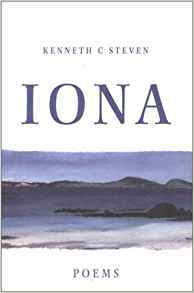
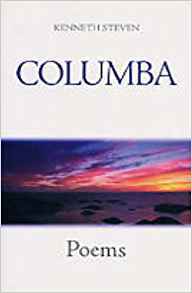
Order Kenneth Steven's Books
A Song Among the Stones: Poems
The Sound of Iona (an audio CD)
Kenneth has also published fiction and nonfiction titles
(using the Amazon links above help to support the Abbey scholarship fund at no additional cost to you)

Dreaming of Stones
(available to pre-order)
Christine Valters Paintner's new collection of poems Dreaming of Stones will be published by Paraclete Press this March.
The poems in Dreaming of Stones are about what endures: hope and desire, changing seasons, wild places, love, and the wisdom of mystics. Inspired by the poet’s time living in Ireland these readings invite you into deeper ways of seeing the world. They have an incantational quality. Drawing on her commitment as a Benedictine oblate, the poems arise out of a practice of sitting in silence and lectio divina, in which life becomes the holy text.

February 2, 2019
Love and Radical Hospitality ~ A Love Note from Your Online Abbess
 Dearest monks, artists, and pilgrims,
Dearest monks, artists, and pilgrims,
Valentine's Day is coming, which for many of us is a holiday that only serves to make us feel inadequate, as all highly commercialized things do. And yet the message of love is worth repeating if we can look beneath the chocolate hearts and flowers and the expectation that we all be in a significant relationship or be lacking.
Hospitality is the heart of our work – creating a safe space where we can begin welcoming back in the stranger within and in the process discover the hidden wholeness of which Thomas Merton wrote. This kind of radical hospitality is also an act of great love. Over the years, I have come to realize, that more than anything else I do, this work of healing is most essential. The Abbey, too, strives to be a safe place where a diversity of people with a wide range of beliefs and convictions can gather. I love that people show up each with their own longings.
Maybe there is a deep loneliness as this holiday of roses and Hallmark approaches. What would it be like to welcome in that lonely part of yourself and to love him, to trust that she has a place in you? Maybe there is self-judgment and criticism that you try to push away. What would it be like to make space to sit with these difficult parts with compassion and listen to what they really want to tell you? This would be a generous act of loving.
This radical hospitality is a lifelong journey. We are always discovering new aspects of our inner world which we reject or resist and need love and care. And in the process of welcoming them in, we perhaps begin to discover that others don't annoy us quite so much. As we grow more intimate with our own places of exile and woundedness, we discover a deep well of compassion for the strangeness of others. As we come to know our own compulsions and places of grasping, we can offer more love to those in our lives struggling with addictions and other places where freedom has been lost.
For the last few years I have signed this love note "With great and growing love”. I started this practice after finding some old letters written by my mother and father to one another in the early days of their marriage. I had forgotten that one of their terms of endearment for one another was "GGL" which stood for "great and growing love." These missives all began and ended with those three letters.
Even though my parents' wounds eventually led them to separation and my father to rejecting much of the love offered to him toward the end of his life, I still treasure this image. I cherish knowing that there was this sense of love abiding between them, growing slowly. Rather than feeling despair or cynicism, I actually feel a great tenderness to know of all the places love plants her seeds.
I love each of you, my dear monks, I don't think the intensity of this work is sustainable without that kind of love. I love your seeking hearts. I love your desire to find a more compassionate way to be in this life and on this earth.
As I continue to offer love to myself through acts of trust in my body's wisdom and welcoming in the less flattering parts of myself, the love grows.
My invitation to you, as Valentine's Day approaches, is to consider whether your love for your own beautiful self grows each day, knowing that there will be days of such self-disdain it might not be possible, and then you welcome in that small and wounded place and discover a hidden fountain of love beneath. Once we begin welcoming in the places we resist, we find that the deep peace of silence can be ours.
This week, let your prayer be "welcome" to every stranger arriving at the inner door and an act of trust in the wholeness that you are.
And know of my love for you, which is always growing.
With great and growing love,
Christine
Christine Valters Paintner, PhD, REACE
Photo © Christine Valters Paintner
January 29, 2019
Monk in the World Guest Post: Katy Taylor
I am delighted to share another beautiful submission to the Monk in the World guest post series from the community. Read on for Katy Taylor's reflection on presence practices.
Growing up in a family that put a lot of value on work, in combination with being an Enneagram type One, I have had to consciously practice in order to learn to slow down to the pace of nature, of my body, of the seasons… For many years, while I loved how I felt in nature, when resting, at ease, or in meditation, it’s been a big challenge to prioritize this over getting things done right and on time.
Especially when I am caught in a cycle of working, what helps me to return to the holiness and grace of the present moment are what I call presence practices, infused throughout the day. These simple practices mark the rhythm of the day and the seasons, and include somatic awareness and movement, singing, mantra, blessing, gathas (mindfulness verses), and prayer.
In the morning, when I awake, the first thing I do is listen to and move my body. Usually she wants to elongate and reach toes and fingers away from each other, or to gently rock the pelvis forward and back, arching and flattening to bring mobility and fluidity.
Then I say a prayer in bed, with my hands on belly and heart, welcoming myself. I prefer to learn a prayer by heart and to pray it for months or even years so that it gets into my bodysoul (body-heart-mind-soul) in a deeper way, feeling like a home, a refuge for my mind, a channel for my heart. I have a few on rotation now, depending on my mood—an adaptation of two of Marianne Williamson’s morning prayers (from Illuminata), the first stanza of e.e. cummings “i thank you god, for most this amazing day…,” and Thich Nhat Hanh’s Waking Up gatha (mindfulness verse).
I arise slowly, and once out of hearing range from my husband, I sing a morning blessing, depending on the energy of the day—anything from “Morning light calls my body…” to the more rowdy “Do you want to sing open the morning…” (Laurence Cole). Singing voices me, embodies me, helps my soul feel present in / as / with my body.
If it’s moving towards dawn, I’ll sing a song about the interface of light and darkness, and when dawning light arrives, looking out to the sky, I sing “Welcome daytime, welcome light…” (adaptation of a round by Mountain Falls). Sometimes I do a few rounds of bowing, surrendering my life to God in the unfolding of the day. I begin with hands at heart, then reaching up to the heavens, and coming back through the heart, blending heaven and earth as I move down through hands and knees to Child’s pose. Here I rest with my head on the floor, below my heart, taking a few humble breaths, and then reversing the process until I arise, standing as a human being, chalice of God. This practice can also support me during the day.
With my morning practice, a tea gatha from Thich Nhat Hanh blesses my first cup of tea: “This cup of tea in my two hands / mindfulness held completely / my mind and body dwell / in the very here and now.”
Morning practice usually concludes with movement to honor my body’s need for moving expression. In addition to SomaYoga, I have found the many movement practices from Camille Maurine (Meditation Secrets for Women) to be particularly helpful in connecting with my body’s rhythms with all beings. I pulse, reach, roll, elongate, contract, slide, glide, flow, release (and more!), following my bodysoul’s promptings, her desire to be fully alive, allowing sound and adding mantras as needed: “I give breath/life/love; I receive breath/life/love” (Camille). Often a song accompanies me, too: “Trees grow slow” (Laurence Cole), “Steady as a rock” (unknown), or “I am me” (Paul Barton).
In the kitchen, a blessing song or grace over the food I am preparing and eating reminds me of the sacredness of life nourishment becoming my body—“Bless this food, bless my life…” or “May we be happy, may we be loved and well-fed…” or another call to presence.
Throughout the day of work, index cards of practices at my desk remind me, among other things, that “Life loves me,” to breathe consciously, or to say thank you to everything I meet today. Tea always accompanies my work as a healing, calming presence. Singing also supports me—“There is work to be done…” (Sarah Nutting), which also includes a reminder of a “wide heart” or “The only way through is through…” (Diane Baker), with its reminder to take one step at a time or “Í am calling you,” reconnecting me with my deep soul-yearning for God. On breaks, I look out or step out into the season, savoring its invitation to be, to be blessed, to be present, or connect with my husband or a friend. These practices give my work experience living, breathing, singing expression, helping my soul feel presenced, here.
At the end of the work day, a closure gatha based on Thich Nhat Hanh’s Waking Up gatha helps me surrender the work day and embrace my need for rest, pleasure, and relaxation. If I didn’t do a yoga-nidra meditation as a break, I might do it now, or often a walk helps me reconnect, breathing in the air, feeling my feet, taking in the sounds and sights of the neighborhood—and if needed, a gatha like “present moment, wonderful moment” (Thich Nhat Hanh) or another song.
Dusk invites another round of “Light and darkness” (unknown) and the evening song “Welcome darkness…” (Mountain Fall’s original version).
Bedtime includes a gratitude practice, a surrendering the day song, and another Marianne Williamson prayer, learned by heart.
This choice to sing, pray, and bless myself continuously throughout the day calls me back to presence, rewiring my brain to see through God’s eyes instead of my workaholic, speedy ego’s eyes, and brings my whole bodysoul alive. I am blessed.
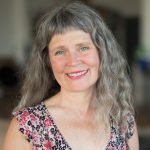 Katy Taylor is a Holistic Life Coach, SomaYoga Teacher, Vocal Coach and singer, and Interfaith Minister. She helps people practice presence to come home to their bodysoul and find more ease and resilience in their lives. She has a free e-book of practices on her site: https://katytaylor.com/welcoming-the-sacred/.
Katy Taylor is a Holistic Life Coach, SomaYoga Teacher, Vocal Coach and singer, and Interfaith Minister. She helps people practice presence to come home to their bodysoul and find more ease and resilience in their lives. She has a free e-book of practices on her site: https://katytaylor.com/welcoming-the-sacred/.
January 26, 2019
The Feast of Brigid and Imbolc ~ A Love Note from Your Online Abbess
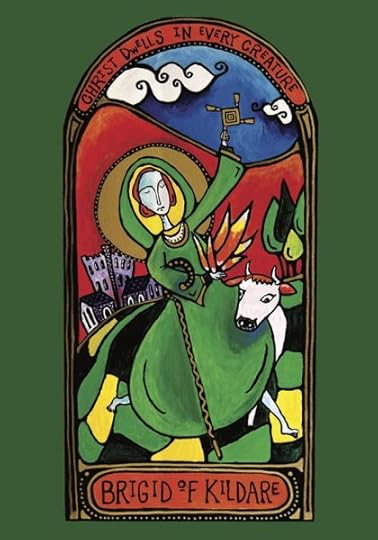 St. Brigid at the Market
St. Brigid at the Market
I saw her in the market
backlit in the doorway
from the evening sun,
blue cloak ripples like water
dandelions and primrose in her hand.
Passersby brush past
this moment of light and song
in a rush to get shoes off
and dinner on, just another day
of traffic, bills, and angry bosses.
I stood, mouth open,
holding three lemons,
a pile of sunlight,
a miracle in yellow,
tiny halos
a little girl stops next to me,
giggles, points to the door,
her mother’s yank
drags her back to the world of lists.
I fear I will forget
this supermarket vision late tonight,
reaching for the bowl of lemons
and simply seeing fruit.
–Christine Valters Paintner
Dearest monks and artists,
February 1st-2nd marks a confluence of several feasts and occasions including: the Celtic feast of Imbolc, St. Brigid’s Day, Candlemas, Feast of the Presentation, and Groundhog Day in the northern hemisphere! (Imbolc is August 1st in the southern hemisphere).
Imbolc is a Celtic feast that is cross-quarter day, meaning it is the midway point between the winter solstice and spring equinox. The sun marks the four Quarter Days of the year (the Solstices and Equinoxes) and the midpoints are the cross-quarter days. In some cultures, like Ireland, February 2nd is the official beginning of spring.
As the days slowly lengthen in the northern hemisphere and the sun makes her way higher in the sky, the ground beneath our feet begins to thaw. The earth softens and the seeds deep below stir in the darkness. The word “imbolc” means “in the belly.” The earth’s belly is beginning to awaken, new life is stirring, seeds are sprouting forth.
In many places the ground is still frozen or covered with snow, but the call now is tend to those very first signs of movement beneath the fertile ground. What happens when you listen ever so closely in the stillness? What do you hear beginning to emerge?
St. Brigid is said to bring the first sign of life after the long dark nights of winter. She breathes into the landscape so that it begins to awaken. Snowdrops, the first flowers of spring are one of her symbols.
On the eve of January 31st it is traditional to leave a piece of cloth or ribbon outside the house. It was believed that St Brigid’s spirit traveled across the land and left her curative powers in the brat Bride (Brigid’s Mantle or cloth). It was then used throughout the year as a healing from sickness and protection from harm.
Often in Ireland, I have heard Brigid described as a bridge between the pre-Christian and Christian traditions, between the other world and this one. She bridges the natural and human world. Brigid sees the face of Christ in all persons and creatures, and overcomes the division between rich and poor. Our practice of inner hospitality as monks in the world is essentially about healing all of places we feel fragmented, scattered, and shamed. One of her symbols is her cloak which becomes a symbol of unity. All can dwell under her mantle.
(The prose section was excerpted from our self-study retreat Sacred Seasons)
The poem above is from my first full collection of poems titled Dreaming of Stones being published by Paraclete Press which you can pre-order and is available in March!
With great and growing love,
Christine
Christine Valters Paintner, PhD, REACE
P.S. Our southern hemisphere dancing monks can find a reflection on Lughnasa at this link>>
Dancing Monk icon of St Brigid © Marcy Hall at Rabbit Room Arts (prints are available in her Etsy shop)
January 22, 2019
Monk in the World Guest Post: Emily Wilmer
I am delighted to share another beautiful submission to the Monk in the World guest post series from the community. Read on for Emily Wilmer's reflection, "The Dance: Spirit, Prayer and Laughter."
We skipped church this morning. We skipped for two reasons. It’s Trinity Sunday, and as much as I appreciate the clergy staff at our church, I couldn’t bear the thought of one more Sunday when someone tried to explain the Trinity. The other reason is that yesterday I spent 6 hours in the yard digging up a new garden area, amending the soil, planting flowers and spreading mulch. My body is tired and sore, but that good kind of sore; a grateful sore that I can still do it.
So this morning I got my slow moving body out of bed, had a slow moving breakfast with strong Welsh tea with David, and heard a few words of wisdom from the early Christian desert father, Abba Moses the Robber. We then went down to our lovely oratory for our morning contemplative prayer.
This is a space that we remodeled into a place specifically for prayer and nothing else. This little oratory is set aside only for listening for the Mystery we call God. We are surrounded by rich and colorful icons of the life of Christ and oil lamps that bring a soft glow to everything in the room; including us. It is a room of Presence and energy in which we place ourselves with the continuing desire to know Jesus, the Risen Christ. We pray that our mind, heart and bones are soaked with the renewing light and love of the Christ.
So this morning we each took our turn at the threshold, bowing in reverence before stepping across to take our place. We each sat down, took up our shawl or prayer beads and prepared for the sound of the meditation bell and the opening chant to follow. David struck the wooden bell to call us to attention. He then struck the large bronze meditation bell to signal our entry into silence. He’s had a cold for three days now and finds it hard to chant because of the congestion in nose and throat but thought he would try again this morning. He began the opening chant . . . but stopped after the first three words.
“You’ll have to do the chant. I can’t chant and breathe at the same time – even for God”
He chuckled but I laughed out loud . . . and I continued laughing. He caught my laughter and it grew and grew until the room was saturated with laughter. We couldn’t stop; it kept growing no matter how we tried to stifle it or mute it or stop it. The laughter just kept growing until I finally took a deep breath and said, “Okay, okay, I’m stopping now" . . . and then started laughing again. I was laughing so hard I was crying and my stomach muscles were beginning to hurt. It was WONDERFUL!
As G. K. Chesterton said: “Angels can fly because they can take themselves lightly."
We did finally settle down and enter into the silence but silence enriched with our laughter. Half way through our sitting time, my eyes fell on the Rubelev icon of the Trinity – the three persons sitting at table. Perichoresis is a word often used to describe the energetic dynamic of the Trinity. It is from two Greek words, peri meaning ‘around’ and choresis meaning ‘dance’ or dancing’. When you put them together you have ‘dancing in relation to another’. I love that: a dance of the energies of the Father, Son and Holy Spirit.
As our time of meditation and prayer was coming to a close; a thought swept into my mind:
If anyone wants to know what the dance of the Trinity sounds like, all they need do is experience prayerful laughter! Spirit, prayer and laughter all dancing around together right here in our little oratory in the Blue Ridge Mountains.
I wonder:
When have you been surprised by the convergence of laughter and prayer?
When have you experienced the Spirit running wild in unexpected places?
Might the Holy One be delighted when our laughter breaks into our intense focus and reflection . . . and gives not only us, but God, a brief moment of pure merriment?
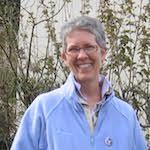 Emily Wilmer is a spiritual director, retreat leader, poet and co-director of Oasis of Wisdom: Institute for Contemplative Study, Practice and Living in Asheville, NC. At this time in her life spiritual direction happens in meaningful conversations over tea and a scone; poetry has become her prayer . . . and vice versa.
Emily Wilmer is a spiritual director, retreat leader, poet and co-director of Oasis of Wisdom: Institute for Contemplative Study, Practice and Living in Asheville, NC. At this time in her life spiritual direction happens in meaningful conversations over tea and a scone; poetry has become her prayer . . . and vice versa.
January 19, 2019
8 Practices of a Good Pilgrimage ~ A Love Note from Your Online Abbess
 Dearest monks, artists, and pilgrims,
Dearest monks, artists, and pilgrims,
The value of travel was ingrained in me from a young age. When I was growing up in New York City my father worked for the United Nations, and we had the privilege of traveling back to Austria, where he was from, as well as other European countries and once as a teen through Asia.
As an adult I began to see the potential for deeper meaning in my journeys. I saw a difference between travel as a tourist and making a journey as a pilgrim. I often define pilgrimage as courting holy disruption. We go on a soulful, intentional journey to break ourselves open in new ways. As tourists we want everything to go according to plan.
Pilgrims welcome the opportunity for changing course and perspective along the way. Pilgrimage is an inner journey in response to outer movement. Sometimes the journey doesn’t involve any physical relocation. We might embark on pilgrimage because of illness or transition in our lives and find that we are moving into new internal territory. The old structures no longer hold. This is the practice of hearing the call—whether it was a call we desired or it came unbidden. When we respond and say yes to the journey, it takes us on, and then we become pilgrims. When life beckons we can resist at every turn, or we can recognize that things are changing and our invitation is to open ourselves.
The journey calls us to pack lightly. We discover that the old ways, habits, and patterns no longer serve us. Perhaps we feel an impulse to simplify our lives so that we have more room and resources for the new that is emerging. Travel is easier with light bags. We ask ourselves: What do we want to carry forward?
We then cross a threshold, which is a space between. The old has fallen away and the new hasn’t yet emerged. Thresholds are sacred places in the Celtic imagination where the veil between heaven and earth is considered thin. When we open ourselves to the liminal and stop grasping at the way things were, we may discover a variety of unseen presences supporting us along the way.
Embarking on pilgrimage may tempt us to seek the well-worn path, but the essence of the true inner journey is finding our own way forward. The poet Antonio Machado says that “the way is made by walking.” We put one foot in front of the other and the next step is revealed only as we are in movement. This demands a great deal of trust and listening for the whispers of the divine along the way.
The Latin root of the word pilgrim is peregrini, which means “stranger.” We go on pilgrimage to become strangers to all that is familiar, to break out of our routine vision of the world and discover something new. This requires that we stretch, travel to wild edges, and risk being uncomfortable. It is in that discomfort that we encounter new dimensions of our own capacity and new faces of the sacred.
Along the way we will encounter our own limitations again and again. We will find ourselves resisting or forgetting our spiritual practice. In the monastic tradition there is great value placed on “beginner’s mind” and the honoring of our humanity. When we stray too far from our own deep desires of the heart, we are issued an invitation to always begin again.
Ultimately the pilgrimage journey asks us to embrace mystery, to walk into unknowing, to relinquish our grasp on certainty and control. In that process we allow ourselves to be broken open to receive gifts far bigger than our own limited imaginations could ponder.
And finally the journey always calls us back home again with renewed awareness. Even if we never left home physically on pilgrimage but made the deep inner journey, we discover that home is a deep, abiding presence within us and see the familiar in new ways. We return with the gifts that we were offered along the path.
These eight practices are all part of an inner pilgrimage of discovery, where we may not even travel past our own neighborhood. But by seeing our experience with new eyes we can find ourselves and God in new ways.
Pilgrimage is an ancient call and practice. Any time we approach life in this way, we join with the millions before us who have felt drawn to wander and see life through a new lens and to trust in the unknown. We can open ourselves up to God’s work through our inner and outer journeys in the everyday. No plane tickets required.
(This article also appears in the July 2018 issue of U.S. Catholic (Vol. 83, No. 7, pages 12–17) as well as on their website.)
Please join us for our Lenten online retreat as we journey through my book The Soul of a Pilgrim together in community.
With great and growing love,
Christine
Christine Valters Paintner, PhD, REACE
Photo © Christine Valters Paintner
January 15, 2019
Monk in the World Guest Post: Kathleen Schwab
I am delighted to share another beautiful submission to the Monk in the World guest post series from the community. Read on for Kathleen Schwab's reflection, "Love God Like a Falcon."
On my bed I remember you; I think of you through the watches of the night.
(Psalm 63:6 NIV)
The relationship between God and a human being is unique, and describing it or making analogies can be tricky. After all, it is essentially unlike any other relationship we have with anyone or anything else. Over the last few years, I’ve found something that unexpectedly offers some insights into the human/God relationship: I’ve been studying birds of prey, and the falconers who work with them.
A process called “manning,” used in training hunting falcons, presents some intriguing parallels to the Christian life. Manning builds the bond between the human and avian partners, and makes them a strong team in the field. This type of training is available to us in our Christian lives too: I think of it as “God-ing.” It is something that God offers us at any time, and it will make us far more effective in finding our way through the unpredictable challenges of life.
To understand this analogy, you first have to understand what a unique relationship people have with their trained birds of prey. The issue is the falcons’ freedom: they can fly away if they want, go live on their own in the wild. While hunting, falcons climb hundreds of feet in the air: with the human earth-bound far below, the birds cannot be forced to return. Falconers win their birds over by demonstrating a human partner’s value, making landing yet again on the falconer’s glove the most attractive option.
To prove his or her value, a falconer takes the bird to a good spot, sends it high in the air, and then flushes out some game from the surrounding bushes. While the trained falcon gets lots of prey sent into range, the solitary falcon may have to wait patiently for hours until one animal happens to be in the right place. Most falcons quickly realize how much better life is with a human hunting partner, and choose to return again and again.
A trained falcon is an amazing thing: a wild creature that develops a working partnership with a human, yet retains its wild nature.
Here is where manning comes in as a part of the training regimen. Manning means falcons spending time with humans while not hunting. Falconers may do some manning on a rainy day when flying isn’t possible: the falcon spends the day in the house among people, sitting quietly on an arm while the human works on the computer, does chores, or watches T.V. The bird gets the chance to observe the ways of its flightless hunting partner on an ordinary day. Manning can look like nothing much is going on, but if done regularly, both falcon and falconer will have a much better sense of how to read each other’s body language, and how to respond quickly to each other’s signals. Manning builds both understanding and trust.
God-ing is spending time with God outside of church attendance and structured devotions: it means continuing attention towards God while we live regular life. “Remain in me, as I also remain in you.” (John 15: 4) God's attention does not leave us, although God has given us the freedom to ignore it. But if we spend time simply paying attention to God, to how God operates in our lives, if we study God as a mystery worth knowing, we will reap the rewards of a relationship like no other.
Like falcons, human beings have amazing freedom. God made us, but we can fly away from God, and choose to live life on our own. “He causes his sun to rise on the evil and the good, and sends rain on the righteous and the unrighteous.” (Matthew 5:45 NIV) We are not forced to believe in God in order to survive, or to have access to all the good things in the world. But if we decide to live under God's guidance, so much more will be available to us. God can direct us: God can help us to do more than we could ever hope to do alone.
But as for me, the nearness of God is my good. (Psalm 73:28)
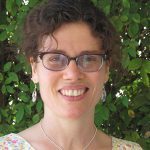 Kathleen Schwab is a lifelong lover of God, a literature teacher, and a wife and mother. Together with her book partner Therese Kay, she is the author of Messages from God: An Illuminated Devotional, a five week devotional inspired by the synergy of words and art in medieval illuminated manuscripts. Visit her online at MessagesFromGodDevotional.com
Kathleen Schwab is a lifelong lover of God, a literature teacher, and a wife and mother. Together with her book partner Therese Kay, she is the author of Messages from God: An Illuminated Devotional, a five week devotional inspired by the synergy of words and art in medieval illuminated manuscripts. Visit her online at MessagesFromGodDevotional.com



